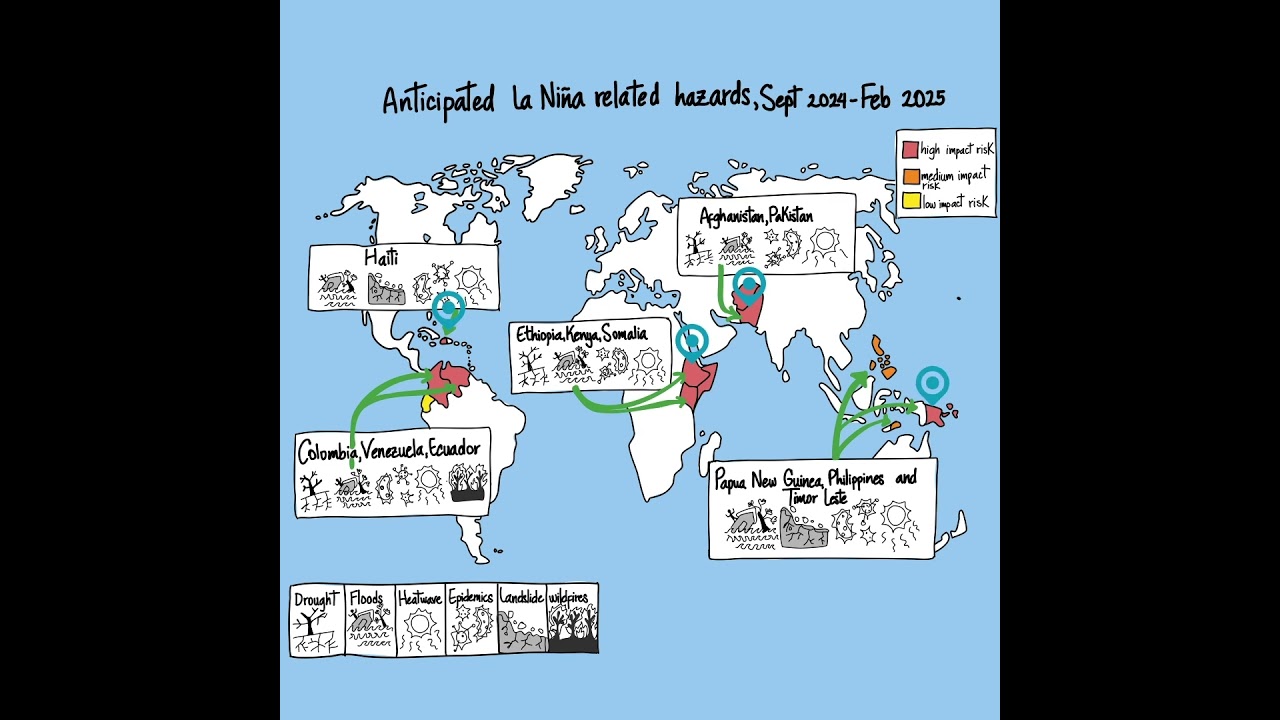
Increasing humanitarian needs
Between late 2024 and the beginning of 2025, several countries already facing humanitarian crises may experience floods, droughts, and epidemics as a result of La Niña-related precipitation and temperature anomalies.
These are likely to increase the humanitarian needs of exposed populations, with food security and health expected to be the most affected sectors. El Niño affected global weather patterns from July 2023 to May 2024, with its peak occurring between September–December 2023.
Some countries faced drier-than-usual conditions, while others experienced heavy rainfall and flooding beyond the expected levels for their typical rainy season. El Niño already aggravated humanitarian needs in countries in crisis, especially for food and health services
What does ENSO stand for?
ENSO stands for El Niño–Southern Oscillation, a periodic fluctuation in sea surface temperatures and in the air pressure across the equatorial Pacific Ocean.
ENSO is one of the main drivers of interannual climate variability. The two extreme ENSO phases are El Niño and La Niña. El Niño occurs when the surface waters in the central and eastern Pacific Ocean become warmer than average, while La Niña occurs when these waters become cooler than average.
These changes in sea surface temperatures can cause shifts in atmospheric pressure and winds, leading to changes in rainfall patterns, temperature, and other weather-related phenomena worldwide.
Climate change can amplify the rainfall variability related to ENSO and increase the likelihood of extreme weather events. Global warming is also increasing ENSO variability, and strong El Niño and La Niña events have occurred more frequently than the pre-1960 average.
More frequent swings from a strong El Niño to a strong La Niña are anticipated in the future.
Climate change has the potential to amplify La Niña-induced rainfall and temperature anomalies, triggering unpredictable and potentially more extreme outcomes.
Humanitarian impacts from La Niña in 2024 - 2025
Countries at risk
Click on this interactive diagram to explore the rainfall and temperature anomalies, the associated hazards, and the main humanitarian impact dimensions of La Niña.
GLOBAL HUMANITARIAN IMPACTS OF LA NIÑA
How does ACAPS assess the risk of La Niña impact?
The assigned risk level to the impacts of La Niña is based on expert judgement following an assessment per country of the indicators and factors listed as follows:
historical impact of previous La Niña events in the country
typical influence of La Niña from September to February in the country
seasonal precipitation and temperature forecasts
pre-existing humanitarian crises and vulnerabilities to La Niña-induced hazards
agricultural seasonality
national and local response capacity to natural hazards and their impact
expected impact on agriculture, livestock, and fishery
potential spillover effects of La Niña on local food prices and the economy
potential disease outbreaks and increased health needs.
Analysis products
on
El Niño & La Niña Global Analysis
22 April 2025
Myanmar: Exposure to seasonal hazards in earthquake-affected areas
DOCUMENT / PDF / 421 KB
Myanmar has recently been struck by a magnitude-7.7 earthquake and is approaching the start of its monsoon and cyclone seasons, with forecasts predicting above-average rainfall and temperatures. These challenging conditions, coupled with conflict, poverty, and diminished coping capacities, may present significant risks to the population.
13 November 2024
The Philippines: Impact of Tropical Cyclone Trami (Kristine) and Kong-rey (Leon)
DOCUMENT / PDF / 481 KB
By 11 November, Trami and Kong-rey had affected over 9.6 million people in 17 of the country’s 18 regions. By 12 November, there were nearly 893,000 people in humanitarian needs. By 31 October, a total of 160 cities and municipalities across the country had declared a state of calamity.
31 October 2024
Mexico: impacts of Hurricane John
DOCUMENT / PDF / 334 KB
The Pacific Coast of Mexico received the first landfall of Hurricane John on 23 September and then the second landfall on 27 September. Over 280,000 people have been affected in Guerrero and Oaxaca state, and at least 39,000 houses were damaged in Guerrero state. Over 40,000 hectares of crops have been destroyed.
30 October 2024
Cuba: impact of Hurricane Oscar
DOCUMENT / PDF / 214 KB
On 20 October 2024, Hurricane Oscar landed in Cuba as a Category 1. In Guantanamo province, floods and landslides particularly affected the municipalities of Baracoa, Imías, Maisí, and San Antonio del Sur. By 22 October, at least 15,000 people were affected, including seven fatalities.







